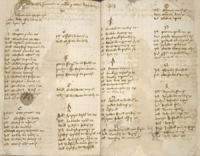 |
 |
 |
 |
 |
 |
 |
|
Fountains Abbey: History
Fountains Abbey: Buildings
|
The abbey's servants (6/10) As a leading official of Fountains in the mid-fifteenth century, Thomas Swinton was responsible for the abbey’s dealings with its tenants and servants, for recording wages, credits and debts, and noting what was paid and what was outstanding. His duties took him to the law courts, to sort out litigation, as well as to towns and villages where he purchased household goods, overlooked sheep-shearing and cattle-rearing, and collected rents. Swinton’s ‘Memorandum Book’ is therefore an important source of information for the servants at Fountains in the mid-fifteenth century, and includes a list of all the abbey’s servants in c. 1456. The names of these men – 117 in total – are recorded in alphabetical order and state their occupation, such as ‘labourer’, ‘cook’, ‘swineherd’, ‘carpenter’ or ‘abbot’s gentleman ’ (generosus).(109)
Information regarding the abbey’s servants
in the sixteenth century is provided by the Fountains Abbey lease
Book, a compilation of some 270
documents relating to lands and bonds, which was begun during William
Thirsk’s
abbacy (1526-1536); it has been dated to 1533.(110) The
documents in the lease book date from the second half of the fifteenth
century until shortly before
the dissolution of the abbey. The lease book reveals details about the duties and conduct expected of servants and tenants of the abbey. It shows that wages and rents were at this time paid in cash and not in kind, as was often the case in the fifteenth century, and indicates that servants might also become tenants of the abbey. In 1512, for example, the keeper of the west gates at Fountains, Robert Dawson, leased lands from the abbey in Aldfield.(111) In addition to these official servants of the abbey, Fountains also made odd payments to entertainers, messengers and other men and women who provided their services in some shape or form. Details of these gratuities can shed considerable light on the diversity of life at Fountains in the later Middle Ages, of the commonplace and the exceptional. There were payments, for example, to minstrels and fools, to the leader of the Corpus Christi players, and also to scribes, heralds, doctors and lawyers. Other recipients included local men who helped find stray animals, such as the fawn that was recovered in 1457/8, or who guided the abbot or a monastery official through unknown territory. The records also show that women were employed to help at harvest, although the precise nature of their work is not specified. Few women were otherwise engaged by the abbey, although in the sixteenth century Robert Dawson’s wife, Ellen, laundered the linen for the buttery, common guesthouse and the abbot’s chamber, making any necessary repairs. The same document mentions that another washerwoman (lota) did the same work for the monastery.(112) |
